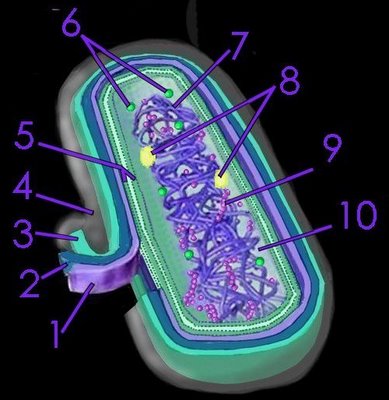Cyanobacteria
Currently, the oldest known rocks (4.4 Ga) and the oldest known microfossils (3.45 Ga) are found in Australia. The microfossils are those of Cyanobacteria found in ancient stromatolites. Cyanobacteria, misleadingly called “blue-green algae”, are ancient photosynthetic, autotrophic (photoautotrophic) eubacteria currently found in many environments. These organisms are much larger than other eubacteria—large enough that they can be identified under a light microscope by their morphological features, which have changed little in the billions of years since they first arose.
Cyanobacteria may be unicellular or they may aggregate in colonies. Colonies of carbonate-forming Cyanobacteria are found in stromatolites in a few stressed environments around the globe. Formerly, stromatolites formed extensive reef structures.
Compare the generalized Cyanobacterium (right) with the generalized prokaryotic cell.

1. cytoplasmic membrane
2. cell wall - gram negative
3. capsule
4. mucoid sheath
5. paired thylakoid membranes studded with phycobilosomes
6. cyanophycin granules
7. nuclear material - nucleoid
8. carboxysomes (polyhedral structures that resemble bacteriophage heads. Carboxysomes comprise 5-6 proteins forming a shell around the ribulose bisphosphate carboxylase. Carboxysomes are believed useful in situations of low carbon dioxide concentration because they concentrate CO2 inside the structure, increasing the efficiency of ribulose bisphosphate carboxylase.
9. 70s ribosomes
10. cytoplasm
Cyanobacteria may live independently or may form symbiotic relationships. Cyanobacteria form lichens in symbiosis with fungi. Depending upon the species of Cyanobacteria and environmental conditions, colonies may form into filaments, or sheets, or hollow balls. Some filamentous colonies are able to differentiate into three different cell types. Under favourable environmental conditions, the usual cell type is vegetative. Thick-walled heterocysts conduct nitrogen fixation by the enzyme nitrogenase. Under stressful environmental conditions, Cyanobacteria form climate-resistant spores.
Cyanobacteria possess an elaborate, highly organized system of internal membranes, which function in photosynthesis. Embedded within these photosynthetic lamellae are chlorophyll a and accessory pigments, such as phycoerythrin and phycocyanin. The lamellae are analogous to chloroplasts' thylakaloid membranes. Photosynthetic pigments impart a variety of colors to the cyanobacteria— violet, deep blue, blue-green, green, yellow, and red.
Division >>> Cyanobacteria (chloroplast)
>> Order Chroococcales > Genus Chroococcus Merismopedia Synechococcus
>> Order Nostocales > Genus Anabaena Nostoc
>> Order Oscillatoriales > Genus Spirulina Trichodesmium
>> Order Pleurocapsales > Genus Pleurocapsa
>> Order Prochlorophytes > Genus Prochlorococcus Prochloron
Cyanobacteria may be unicellular or they may aggregate in colonies. Colonies of carbonate-forming Cyanobacteria are found in stromatolites in a few stressed environments around the globe. Formerly, stromatolites formed extensive reef structures.
Compare the generalized Cyanobacterium (right) with the generalized prokaryotic cell.

1. cytoplasmic membrane
2. cell wall - gram negative
3. capsule
4. mucoid sheath
5. paired thylakoid membranes studded with phycobilosomes
6. cyanophycin granules
7. nuclear material - nucleoid
8. carboxysomes (polyhedral structures that resemble bacteriophage heads. Carboxysomes comprise 5-6 proteins forming a shell around the ribulose bisphosphate carboxylase. Carboxysomes are believed useful in situations of low carbon dioxide concentration because they concentrate CO2 inside the structure, increasing the efficiency of ribulose bisphosphate carboxylase.
9. 70s ribosomes
10. cytoplasm
Cyanobacteria may live independently or may form symbiotic relationships. Cyanobacteria form lichens in symbiosis with fungi. Depending upon the species of Cyanobacteria and environmental conditions, colonies may form into filaments, or sheets, or hollow balls. Some filamentous colonies are able to differentiate into three different cell types. Under favourable environmental conditions, the usual cell type is vegetative. Thick-walled heterocysts conduct nitrogen fixation by the enzyme nitrogenase. Under stressful environmental conditions, Cyanobacteria form climate-resistant spores.
Cyanobacteria possess an elaborate, highly organized system of internal membranes, which function in photosynthesis. Embedded within these photosynthetic lamellae are chlorophyll a and accessory pigments, such as phycoerythrin and phycocyanin. The lamellae are analogous to chloroplasts' thylakaloid membranes. Photosynthetic pigments impart a variety of colors to the cyanobacteria— violet, deep blue, blue-green, green, yellow, and red.
Division >>> Cyanobacteria (chloroplast)
>> Order Chroococcales > Genus Chroococcus Merismopedia Synechococcus
>> Order Nostocales > Genus Anabaena Nostoc
>> Order Oscillatoriales > Genus Spirulina Trichodesmium
>> Order Pleurocapsales > Genus Pleurocapsa
>> Order Prochlorophytes > Genus Prochlorococcus Prochloron
More on the Cyanobacteria








































2 Glossary:
Photosynthesis is the process by which some autotrophic organisms (Cyanobacteria, plants, photosynthetic bacteria, algae) convert water and carbon dioxide into carbohydrates, using sunlight as the source of energy – the process is aided by various forms of chlorophyll.
Stromatolites are defined as "attached, lithified sedimentary growth structures, accretionary away from a point or limited surface of initiation". A variety of stromatolite morphologies exist including conical, stratiform, branching, domal, and columnar types. Ancient stromatolites are commonly thought to have been formed by the trapping, binding, and cementation of sedimentary grains by microorganisms, especially Cyanobacteria. Usually they are found in carbonate sediments, particularly Precambrian sediments. It is often difficult to demonstrate a biological origin, and care should be taken not to assume a biological origin for all "laminated, relief-forming structures" in carbonate rocks. However, obvious fossilized filamentous and coccal micro-organisms are demonstrably present, along with carbon compounds, in many ancient reefs.
Symbiotic: A relationship between two organisms that live in intimate contact with each other. Symbiosis includes mutualism (both organisms benefit, they rely on each other for survival), parasitism (one organism benefits at its host's expense), and commensalism (one partner benefits and the other is neither benefitted nor harmed).
The Eubacteria are a major prokaryotic group of living organisms. The “true bacteria” are microscopic and mostly unicellular, with a relatively simple cell structure lacking a nuclear membrane, cytoskeleton, and organelles such as mitochondria and chloroplasts. Eubacterial DNA contains no introns, and lies free within the cytosol. Unlike the extremophile archaeobacteria, the cell walls of the eubacteria contain peptidoglycan. Eubacteria live in aquatic or soil environments, or as symbiotes within larger organisms. There are five phyla of bacteria: Proteobacteria, Cyanobacteria, Gram-Positive Eubacteria, Spirochetes, and Chlamydiae.
Post a Comment
<< Home